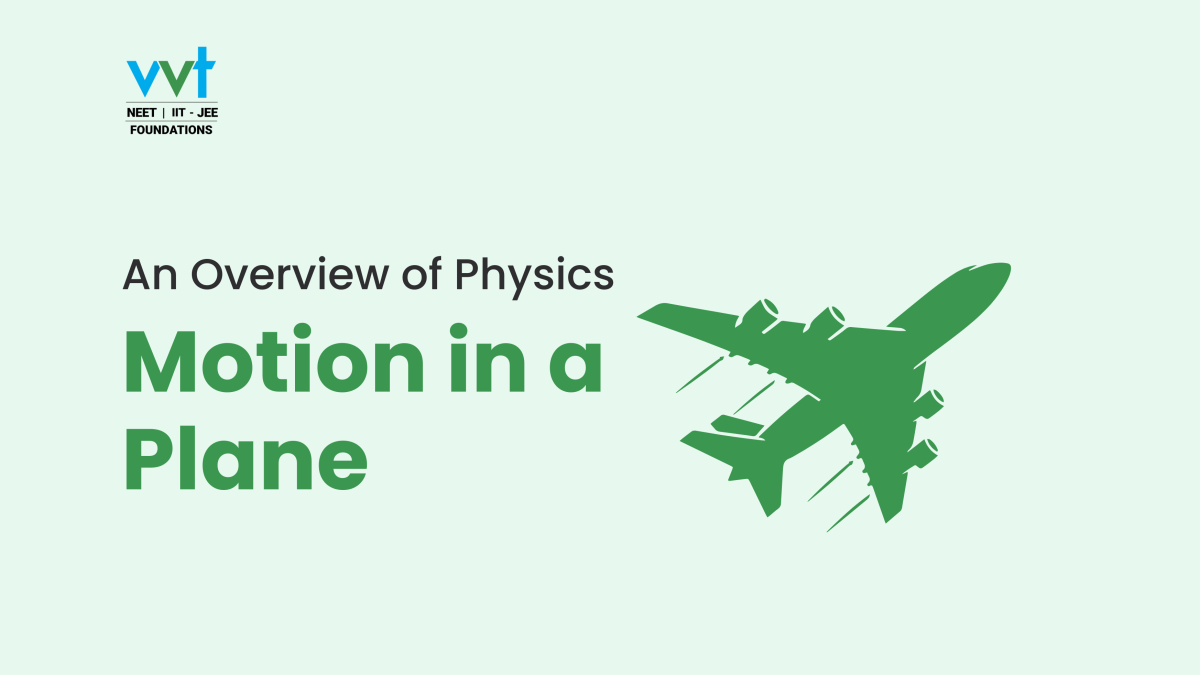
Cell – The Fundamental, Structural, and Functional Unit of Life | NEET Notes | VVT Coaching
April 21, 2025
Motion in a Straight Line: A Comprehensive Guide for NEET 2025 | VVT Coaching
April 23, 2025Motion in a Plane:
A Comprehensive Guide for NEET | VVT Coaching
VVT Coaching Chennai – Ranked #1 Best NEET Coaching Centre by Times Now!
Motion in a plane is a fundamental topic in physics that examines how objects move across two-dimensional spaces. Unlike motion in a straight line, which is simpler, motion in a plane involves changes in both direction and speed, making it essential for understanding real-world phenomena. For students preparing for competitive exams like NEET 2025, mastering this topic is crucial, as it forms the basis for more advanced concepts in mechanics.
At VVT Coaching, we are committed to providing high-quality, exam-focused resources that simplify complex topics and empower your preparation. In this guide, we’ll explore the essentials of motion in a plane—vectors, projectile motion, uniform circular motion, and relative velocity—ensuring you’re well-equipped for success.
Weightage of Motion in a Plane NEET Notes – Last 5 Years
From the last 5 years, questions from this chapter have appeared every year. The average number of questions is 4, and the weightage in NEET Physics is 1.59% to 3%.
| Weightage Following Previous Year’s Trends (2020-2024) | ||||||
| Chapter | Easy | Medium | Hard | Total | Average Q/yr | Weightage |
| Motion in a Plane | 2 | 2 | 0 | 4 | 0.80 | 1.59% |
| NEET Chapter Wise Weightage 2025 for Physics | |
| Topics | Weightage (%) |
| Motion in a Plane | 3% |
Understanding Motion in a Plane
Motion in a plane refers to the movement of an object where its position is described using two coordinates, typically along the horizontal (x) and vertical (y) axes. This two-dimensional framework is necessary for analyzing scenarios where objects do not move in a straight line, such as a ball thrown across a field or a satellite orbiting Earth. For NEET aspirants, grasping this concept is vital, as it directly contributes to solving problems in mechanics and lays the groundwork for topics like rotational motion and gravitation.
Core Concepts of Motion in a Plane
1. Scalars and Vectors
In physics, quantities are categorized as either scalars or vectors. Scalars are measurements that have only magnitude, such as distance, speed, or time. Vectors, on the other hand, have both magnitude and direction, making them essential for describing motion in two dimensions. Examples of vectors include displacement, velocity, and acceleration. Understanding the distinction between scalars and vectors is crucial for analyzing how objects move and interact in a plane.
2. Vector Resolution
To simplify the analysis of two-dimensional motion, vectors are often broken down into their horizontal and vertical components. This process, known as vector resolution, allows us to treat each direction independently. For instance, when studying the motion of a projectile, we can separately analyze its horizontal movement (which remains constant) and its vertical movement (which is influenced by gravity). This method enhances accuracy in predicting an object’s position and velocity at any given time.
3. Projectile Motion
Projectile motion describes the path of an object launched into the air, subject only to the force of gravity after its initial propulsion. The trajectory of a projectile is a curved path known as a parabola. In this type of motion, the horizontal velocity remains unchanged (assuming no air resistance), while the vertical velocity decreases as the object rises and increases as it falls due to gravitational acceleration. Common examples include a thrown baseball, a kicked football, or a launched rocket.
4. Uniform Circular Motion
Uniform circular motion occurs when an object moves along a circular path at a constant speed. Although the speed is constant, the direction of the object’s velocity changes continuously, resulting in an acceleration directed toward the center of the circle. This central acceleration, known as centripetal acceleration, is necessary to keep the object moving in a circular path. Uniform circular motion is observed in various contexts, from a car navigating a curved road to planets orbiting the sun.
5. Relative Velocity
Relative velocity is the measurement of an object’s velocity from the perspective of another moving object or observer. It is a critical concept for understanding how different reference frames affect the perception of motion. For example, the relative velocity of a boat crossing a river depends on both the boat’s speed and the river’s current. This concept is essential for solving problems involving multiple moving objects, such as aircraft navigation or collisions between particles.
Real-World Applications
The principles of motion in a plane extend beyond the classroom, finding applications in numerous fields:
- Sports: Athletes and coaches use projectile motion to optimize throws, jumps, and kicks.
- Engineering: Engineers apply vector analysis to design bridges, roller coasters, and other structures that must withstand dynamic forces.
Key Concepts Table
| Concept | Description |
| Scalars | Quantities with magnitude only (e.g., distance, speed). |
| Vectors | Quantities with both magnitude and direction (e.g., displacement, velocity). |
| Vector Resolution | Breaking vectors into horizontal and vertical components for easier analysis. |
| Projectile Motion | Motion of an object under gravity, following a parabolic path. |
| Uniform Circular Motion | Motion in a circle at constant speed with central acceleration. |
| Relative Velocity | Velocity of one object as observed from another moving object. |
This table provides a quick reference for the core concepts, making it easier for students to review and recall key ideas.
Download the pdf of ‘Motion in a Plane notes for neet’
Conclusion
Motion in a plane is a pivotal topic that bridges theoretical physics with practical applications, making it essential for students preparing for NEET 2025. By understanding the core concepts—scalars and vectors, vector resolution, projectile motion, uniform circular motion, and relative velocity—you’ll be well-equipped to tackle exam questions and real-world challenges. At VVT Coaching, we are dedicated to simplifying complex topics and providing resources that enhance your learning experience. For further study and expert-curated materials, visit VVT Coaching and take the next step toward achieving your academic goals.
Also read:
- NEET Chapter Wise Weightage 2025
- NEET Physics Chapter-Wise Weightage
- NEET Chemistry Chapter-wise and Concept-Wise Weightage
FAQs on Motion in a Plane
- What is the difference between scalars and vectors?
Scalars are quantities that have only magnitude, such as speed or distance, while vectors have both magnitude and direction, such as velocity or displacement. - How does vector resolution help in analyzing motion?
Vector resolution allows us to break down a vector into its horizontal and vertical components, making it easier to analyze motion in two dimensions independently. - What defines projectile motion?
Projectile motion is the motion of an object launched into the air, influenced only by gravity, resulting in a parabolic trajectory. - What is uniform circular motion?
Uniform circular motion is the movement of an object along a circular path at a constant speed, with acceleration directed toward the center of the circle. - Why is relative velocity important?
Relative velocity helps us understand how the motion of one object appears from the perspective of another, which is crucial for problems involving multiple moving objects. - How does motion in a plane relate to NEET preparation?
Motion in a plane is a high-weightage topic in NEET, contributing to questions on mechanics and providing a foundation for advanced physics concepts.











